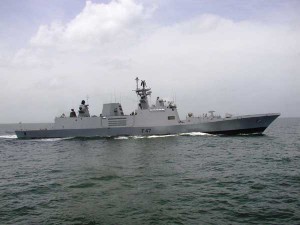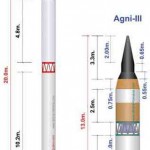How has Shivalik performed in the sea trials? What are the highlights of the signature reductions realised on Shivalik?
Shivalik has undergone extensive sea trials for proving her machinery and ship handling. The sea trials have been very satisfactory and the ship handling has been seen to be very good. The ship sails rock steady even at her top speed. The hull is vibration free and the machinery reasonably quiet.
How does the design of Shivalik compare with other designs of her class? With the experience of Shivalik, what would be the direction for the design of the follow on class P-17A?
 Shivalik design embodies many firsts in IN ships. The CODOG propulsion plant, the Ship Data network (AISDN), the new Total Atmosphere Control System (TACS) for the ship’s air-conditioning and ventilation, IMCS, APMS, the distributed PGD system using EDCs, the IVCS, etc., set her quite apart from earlier designs in terms of design concepts, automation and operational advantages. The ship compares very well with contemporary world designs in terms of capabilities packed into a class of ship of her size. The design and construction of Shivalik have produced a wealth of experience on which to further improve the P17A design. P17A will be more stealthy with covered mooring deck and flush deck mounted (VLM) weapon systems. The number of antennae on the ship will be reduced by use of a multifunction radar. The design will also explore better options for roll stabilization of the platform. In order to help cut down build periods and improve productivity, it is planned to go in for modular integrated construction for P17A. The design, project management and life cycle will be supported by a more comprehensive CAD/PLM.
Shivalik design embodies many firsts in IN ships. The CODOG propulsion plant, the Ship Data network (AISDN), the new Total Atmosphere Control System (TACS) for the ship’s air-conditioning and ventilation, IMCS, APMS, the distributed PGD system using EDCs, the IVCS, etc., set her quite apart from earlier designs in terms of design concepts, automation and operational advantages. The ship compares very well with contemporary world designs in terms of capabilities packed into a class of ship of her size. The design and construction of Shivalik have produced a wealth of experience on which to further improve the P17A design. P17A will be more stealthy with covered mooring deck and flush deck mounted (VLM) weapon systems. The number of antennae on the ship will be reduced by use of a multifunction radar. The design will also explore better options for roll stabilization of the platform. In order to help cut down build periods and improve productivity, it is planned to go in for modular integrated construction for P17A. The design, project management and life cycle will be supported by a more comprehensive CAD/PLM.
How have the other new design projects benefited from the design experience of Shivalik?
Continuous design engagements of the Design organization is vital for the enhancement of design skills and nurturing of design capabilities. After the design of the P-15 class, there was some lull period when no new ship projects were sanctioned. However with the commencement of P 17 in the mid nineties, there was a resurrection of the design capabilities of DGND and the somewhat dormant skill sets got rejuvenated. P 17 is truly a watershed in the design history of the navy in terms of adopting new design concepts and new strategy for the design projects. This has set a definite course for managing and progressing the designs of P15 A destroyers, P 28 corvettes and P 71 Indigenous Aircraft carrier.
What are the challenges faced by the Navy for the new design projects? Is the Navy able to attract quality manpower for specialized tasks like warship design? To what extent, the now available IT tools, have changed the paradigm of design processes?
There are several new challenges faced by the Navy for the new design projects. To meet the genuine new aspirations of the naval staff in terms of required platform capabilities, there is considerable pressure on new indigenous equipment suppliers to meet the more stringent noise and vibration specifications given by the designers. It is a challenging task for the project managers to drive the indigenous suppliers to meet specified standards. It is a recognized fact the world over, that any warship design is an evolutionary process, particularly in an environment of developing industry such as ours. Given this fact, it is very challenging to meet the cost and time budgets for equipment development which in turn impact the ship construction programme. The task of balancing the conflicting requirements of incorporating the latest available technologies whilst freezing specification at a finite time, poses special challenges in a country like ours.
The availability of CAD modelling software with good integration of a Product Data Manager (PDM) will provide a robust platform for optimizing design layouts and maintaining good configuration control in design.
This is so as we are still maturing on many technology areas and would yet like to maintain high indigenous content. Manpower for the specialist tasks of design is another challenge faced by the Navy. However even today, the Navy is the only repository of the large pool of skilled and experienced warship designers. Naval officers, going through the grill of elaborate training in the Navy with wide job profiles relevant to preparing them as designers, still continue to be the most promising feeder source for the naval design organization. With available IT tools, there has been a paradigm shift in design processes. The availability of a suite of initial design software allows a wider exploration for optimizing design.
This has consequently made the process more officer-centric. The wide area network (WAN) connectivity with the shipyards has facilitated easier and faster exchange of design drawings,data and documents with the shipyard. The availability of CAD modelling software with good integration of a Product Data Manager (PDM) will provide a robust platform for optimizing design layouts and maintaining good configuration control in design. The PDM will help capture all relevant data and linked information arranged in an organized product structure. In the near future, the available IT design tools will help progressing designs in a multi-user environment through enterprise wide efforts with collaboration of platform designers, shipbuilders, equipment suppliers and system developers.
What is the Navy expecting from the Indian Industry for the future naval platforms?
The Navy, with several new ship projects on the anvil, is looking for considerable support from the Indian industry to successfully realize the naval ship projects. The industry is urged to invest efforts to develop naval equipment meeting the stringent standards, particularly for noise and vibration, as these are crucial to meeting the performance requirements of the ship. Modularity of systems, with standard well-defined minimum interfaces with the ship will be the thrust for the future. This will help the ship design and construction to proceed on the basis of the agreed interfaces while the equipment supplier can concurrently develop equipment within the confines of the module.
Such an approach will also, to a large extent, accommodate evolutionary designs of state of the art equipment to meet the rising aspirations of the naval staff. P 17 is truly a watershed in the design history of the navy in terms of adopting new design concepts and new strategy for the design projects. This has set a definite course for managing and progressing the designs of P15 A destroyers, P 28 corvettes and P 71 Indigenous Aircraft carrier. This will give confidence to both parties for sharing the risks of development as well share the benefits of new technology with reduced costs.




